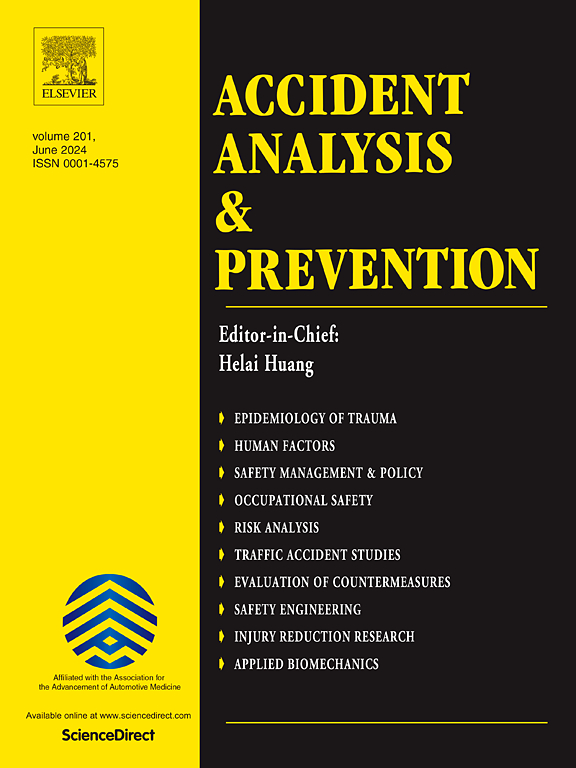Examining collision avoidance behavior of distracted drivers: A correlated grouped random parameters accelerated failure time model with heterogeneity-in-means
IF 5.7
1区 工程技术
Q1 ERGONOMICS
引用次数: 0
Abstract
Current research mostly studied the driving behavior of distracted drivers in abrupt situations, but different types of distraction may lead to differential crash risks, particularly during collision avoidance, which has been overlooked in the literature. As such, this study investigated and compared drivers’ collision avoidance performance under different distraction conditions. Forty-four licensed drivers completed driving simulation experiments under normal driving, cognitive distraction, and manual distraction conditions. To comprehend the collision avoidance behavior under different distraction conditions, this study analyzed hazard response time, deceleration time, and collision avoidance time—critical components in avoiding secondary collisions. For these performance measures, correlated grouped random parameters accelerated failure time models were developed, considering repeated experiment design and unobserved heterogeneity. Results indicate that drivers in manual distraction took more time to respond during the hazard response phase compared to cognitive distraction. The majority of distracted drivers were observed to spend less time decelerating and avoiding collisions than in normal driving conditions, indicating a risk compensation behavior. Further, this study found that gender was associated with differential increase in collision avoidance time, with male drivers having longer collision avoidance time under manual distraction than female drivers and female drivers having longer collision avoidance time under cognitive distraction than male drivers. Overall, this study provides insights into collision avoidance behavior and aids in developing automated collision avoidance assistance systems.
研究分心驾驶员的避碰行为:一个具有均值异质性的相关分组随机参数加速失效时间模型
目前的研究大多是研究突发情况下分心驾驶的驾驶行为,但不同类型的分心可能导致不同的碰撞风险,特别是在避碰过程中,这一点在文献中被忽视了。因此,本研究调查并比较了驾驶员在不同分心情况下的避碰性能。44名持牌驾驶员分别在正常驾驶、认知分心和手动分心条件下完成驾驶模拟实验。为了了解不同分心条件下的避碰行为,本研究分析了避免二次碰撞的危险响应时间、减速时间和避碰时间关键成分。对于这些性能指标,考虑到重复的实验设计和未观察到的异质性,建立了相关的分组随机参数加速失效时间模型。结果表明,与认知分心相比,手动分心驾驶员在危险反应阶段的反应时间更长。大多数分心的司机在减速和避免碰撞上花费的时间比正常驾驶情况下要少,这表明他们有风险补偿行为。此外,本研究还发现,性别与避免碰撞时间的差异增加有关,男性司机在手动分心下的避免碰撞时间比女性司机长,女性司机在认知分心下的避免碰撞时间比男性司机长。总的来说,这项研究提供了对避碰行为的见解,并有助于开发自动避碰辅助系统。
本文章由计算机程序翻译,如有差异,请以英文原文为准。
求助全文
约1分钟内获得全文
求助全文
来源期刊

Accident; analysis and prevention
Multiple-
CiteScore
11.90
自引率
16.90%
发文量
264
审稿时长
48 days
期刊介绍:
Accident Analysis & Prevention provides wide coverage of the general areas relating to accidental injury and damage, including the pre-injury and immediate post-injury phases. Published papers deal with medical, legal, economic, educational, behavioral, theoretical or empirical aspects of transportation accidents, as well as with accidents at other sites. Selected topics within the scope of the Journal may include: studies of human, environmental and vehicular factors influencing the occurrence, type and severity of accidents and injury; the design, implementation and evaluation of countermeasures; biomechanics of impact and human tolerance limits to injury; modelling and statistical analysis of accident data; policy, planning and decision-making in safety.
 求助内容:
求助内容: 应助结果提醒方式:
应助结果提醒方式:


